Journal of
eISSN: 2574-8114


Review Article Volume 11 Issue 1
Istanbul Aydin University, Turkey
Correspondence: Asst. Prof. Dr. H. Meryem İmre, Istanbul Aydin University, Turkey
Received: January 22, 2025 | Published: February 10, 2025
Citation: İmre HM. The development of sandals in different geographies. J Textile Eng Fashion Technol. 2025;11(1):42-46. DOI: 10.15406/jteft.2025.11.00402
Leather had a vital role in very early settled civilizations. The ancient Anatolian civilization historical and cultural values have left a remarkable and permanent indent throughout the centuries. The history of Leather started with Hittites in the form of Çarık/Sandal, which was created to cover and protect feet, numerous civilizations adopted this practice even to today.
Çarık/Sandal has made the evolution of a structure used in different geographies/regions during the Hittite, Egyptian, Byzantine, Seljuk and Ottoman Empire periods and the materials used in the construction of this product known.
This proves how strong the cultural ties of civilizations were reflected in the history of sandals / shoes. The sandal is an object through which we can trace the historical process in terms of social change, technological development, the use of materials and craftsmanship. It is one of the powerful tools of intercultural communication.
In this study, it is aimed to contribute to the World Cultural Heritage by examining the forms, usage characteristics, materials of the sandal shoes of the civilization on the different geography, which is a historical way and brings together many cultural differences. For these purposes, a literature review has been made and some have been examined and visualized.
Keywords: craftmentship, civilization, foot history, sandal, shape, material
When we search for the word Çarık -sandals- two different point of views are discovered. First view as indicated in the Big Larousse from the Turkish Language Association the word Çarık was transformed from Turkish to Hungarian (Saru) and to Farsi and Balkan languages as Çaroğ, Çaruğ. The second point of view was that the word Çarık’s original came from Farsi and was transformed to Turkish as Çarık –sandals-. The word Çarık is known since the Uigur Turks and has been pronounced as Çaruk and Çarık in Ottoman Turkish language.
Sandals and its varieties
Culturel and historical feature of sandals was that they were made of cow rawhide while for the more smooth and soft sandals buffalo rawhide was used. Shaped as a foursquare based upon the foot size and sewed as two types. The first one was called Kara Çarık (black sandals), cut and curved to the size of the foot and tied with straps around the ankle, the other type has an upturned nose form, each side with equally spaced holes from which leather straps are slipped through, this shape was named Dede Burnu.
The Hittite reliefs are confirming that the Dede Burun type sandals has been used during this period. Products made from leather did not last throughout the centuries the reason why that there are hardly any documents and materials left about the history of leather. Sandals were just made according to the feet measurements there was no need nor knowledge for using shoe molding. The improvement of molding shows the ability of human development.
Sandals in the hittite era its specifics
The discoveries made at the excavations done in Alişar and Kültepe show the importance of leather in the Anatolian civilization. The reliefs discovered in Çatalhöyük and Alacahöyük show how much the leather was popular. Hittite’s were wearing a sole with an upturned nose strapped around their ankles or half neck shoes.
On the Alacahöyük reliefs the Hittite’s sole upturned nose shoes were shown. The reliefs in Yazılıkaya shows that Gods and King Vargalavas were wearing the same type of shoes. Later those shoes were named sandals (Figure 1).
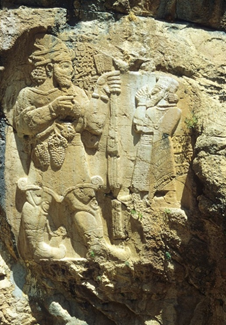
The tackles of the Hittite Kings horse coaches were made from goat leather. Kings slippers were ornamented while their boots were more simple formed with relief designs. Half boots (mid-calf boots) were made from one sheet of leather and used for centuries.
Sandals have been worn with wool socks or by wrapping feet until knee-high with a piece of cloth for easy wearing and walking. The reason for this was the stiffness of the leather sandals which were made from buffalo rawhide or ox rawhide. Hittite reliefs show that sandals were worn by both women and men (Figure 2).
Hittite reliefs describe that for a long period of time sandals have been used by the old and new communities living in the area such as Tanrı dağları, Ural-İdil area, Anatolia and in many communities in the outer areas. Sandals are used commonly throughout times.
Sandals in the Mesopotamia – Egypt Era
In the beginning shoes were unknown objects in Mesopotamia. It has been discovered on the reliefs that Gods and Kings were barefooted.
From the early period of civilization Mesopotamia has been contuniously developed its leather industry because of its geographical location, climate and soil structure, In 3000 BC they started processing leather and improved it throughout.
Shoes have been made from vegetable tanned and dried leather. In my opinion Mesopotomia only needed to produce one type of sandals because of it’s geographical and climate conditions.
Egypt sandals and its features
Worn out leather shoes found in the excavations in Egypt were not the domestic fabricated shoes. In ancient Egypt shoes have been worn initially by nobles, priests and warriors. The reason of taken its place in the history as a status symbol. Kings shoes were made of ox rawhide with several footbed layers. These layers were interconnected by sewing materials using the holes which were made with a pricker.
Tools and features the Egyptians used that time are still the same as they use for handmade shoes today (Figure 3). A pair of sandals were painted in different colors indicating left and right. The designs visualized this too as it indicates the high quality produced. The examples found were in green, purple and red. The community preferred to wear sandals which were quickly to remove and to protect their feet from the heat of the sand.
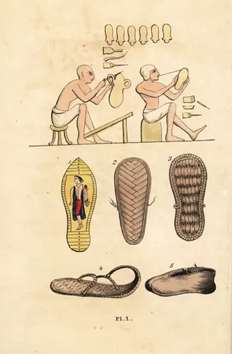
Figure 3 Shoe making tools of Egypt civilization.3
3https://www.prints-online.com/new-images-august-2021/cobblers-making-sandals-shoes-ancient-egypt-23166396.html
As being the most ancient Egyptian shoe; sandals were made of shoe sole leather pinned with straps. Also papyrus or linen woven fabric have been used for producing sandals (Figure 4). For the shoe sole one or two pieces of leather were used. The lower sole sewed with a thick waxed leather thread, the higher sole was sewed with a thin waxed leather thread.
In 2000 BC, the sandals worn by Gods and Kings were also worn by the public. Sandals gained its shape in the ancient Hittite but stabilized its place as sandals in the era of Egypt Civilization; due to geographical conditions, only the upturned nose shaped form has not been changed (Figure 5).
In the late period of Egypt, craftsmen, explorers and warriors who travelled in different geographical cultures brought back their experiences about shoe and sandal forms. Hittite’s upturned nose shaped sandals influenced the Egyptian population. The reason why Egyptian craftsmen started to produce sandals for different professions. For example high heel shoes were made for butchers to prevent standing in the dirt. For more comfort different methods were experienced. First of all, the leather of the heel part has been upsized so that the foot would fit on base. The high heel reduced the abrasion of sand at the same time.
Sandals in the Ancient Greece
In ancient Greece shoemakers were respectable professionals. The reliefs, vase descriptions and pictures of that era show the influences of the tools used to make different types of shoe.
Shoe types were classified according to season, gender and/or rough and elegant. Although main materials for sandals have been ox and deer rawhide, resources denote that felt and linen has also been used. The Knossos descriptions can be seen as examples (Figure 6). Using leather more professional brought out new types such as a longer toe part and a flattened sole. A sandalet sole was made from wood with leather or woven fabric straps tied to the feet.
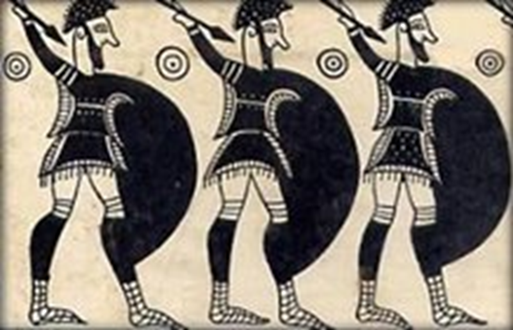
Figure 6 Knossos.6
6https://archaeopteryxgr.blogspot.com/2011/02/blog-post_06.html (Access date: 12.11.2024)
Without making any exception on both gender, sandals for women were made from more softened leather.
Sandals in the Byzantine empire
During the period of the Byzantine Empire, leather and fabric were both used in making shoes. Toe parts were upturned and foot sizes were taken before processing (Figure 7). Byzantine Empire era shoes were made from softened leather, heelless and decorated with gold and jewellery together with silk ornaments. The simple types made from rawhide materials were used by citizens. Purple was the holy color of the Empire therefore they wore purple clothes and shoes.
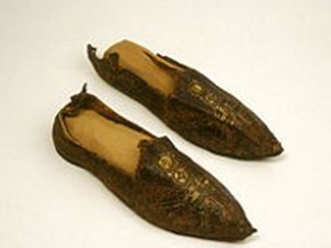
Figure 7 Bizantyne mens shoe (Westminister Catedral).7
7https://www.reddit.com/r/Sneakers/comments/2g05mb/a_pair_byzantine_mens_shoes_6th_century/?rdt
Before Islam: Turkish sandals
Shoes have been the items that confirms the character and social status of human throughout history. Turks especially Göktürk’s wore boots from felt or leather and introduced this type of boots in the Islamic world.
Excavations shows that in the 1st and 2nd century BC half boots were worn. The excavations in Pazırık shows that in the 1st Century BC felt socks and boots were worn. These felt socks and boots belonged to the Great Hun Empire.
The color of boots have been very important in confirming the status among Turks. Red boots have been the symbol of Kingdoms in Central Asia. The design of boots was important too, it showed the value given to them. There were different types of legging boots even up to the knee. The sandals toe part was sharp edged and thightened around the feet by leather straps. This was the first unique type of sandals for Turks. Turks were influenced by the Hittite’s sandal forms.
Sandals and shoes in the Seljuk empire
Leather was important in the Turkish Culture. The Seljuk’s spread out the developed leather in Central Asia and provided them with the best examples, created by the ancestral professionals. Red, yellow and white colors were commonly used (Figure 8).
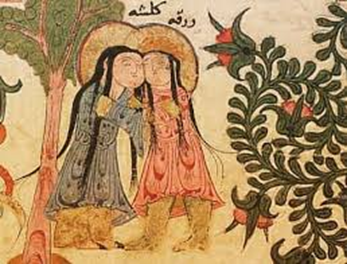
Figure 8 Abdülmü’min el-Hûyî, Varka and Gülşah Mesnevisi Miniature, Topkapı Palace (TSMK), H.841, 33b.8
Because of the climate and geographical conditions boot and shoe originals can not be shown in present time. The reason that all comments is projected on the 14th century miniatures of Varka and Gülşah. On these miniatures besides the boots, they wore sharped edged cut leather shoes with side parts strapped within the form of a foot. The tiles and fresco’s of the Seljuq Era confirms that the upturned nose form was used in red, white colored boots.
Sandals and shoes in the Ottoman empire
During the Ottoman era, the Sultan’s, soldiers and villagers apperal showed differences. A special group of shoemakers were only producing for the Sultan’s in the Ottoman palace (Figure 9).
Shoes worn by public were made by shoemakers called: pabuçcu or başmakçı. Çarık, yemeni, başmak and çizme (boots) as being the most ancient and different type of shoes were worn in combination with the outfits of the Ottoman’s. Sandals or sandal formed shoes in many other cultures located in Anatolia starting from Hittite’s to Ottoman Empire were worn by Kings and Nobles and the Anatolian villagers. Sandals in more varieties are named: kelik, edik, çedik, Arnavut and Karadağ. Used material and colours details, while cattle leather and buffalo leather is its own color. Sahtiyan (tanned goatskin) is available in black, purple called annabi, red called rose-peach and yellow.
During the Ottoman Empire, the form of sandals changed and were named Başmak and Yemeni. The sandal is a foot garment mostly used in Anatolia. People who worked with soil used it because of its easy construction and solidity. As they got closer to the city, the material and workmanship started to change and took different names accordingly. Despite the change of the form the sandals upturned nose shape remained. The type Başmak was worn by moslems only and used by both genders. Those shoes were made from thick leather, having round and flattened noses without the use of any hobnails. The type Yemeni was generally worn by women.
For foot health and comfort reasons, Yemeni type of shoes were favorite in Anatolia.
These types of shoes were known as:
Burnu Sivri: Mainly used in villages, the goatskin of the upper part was curled over.
Merkup: The upper part was short, the back and sides were of equal heights. Used by town people.
Kulağı uzun: The upper part was not indented.
Eğri Yemeni: The upper was short, the toe curled.
Halebi: The upper part was indented on both sides of the feet, the toe curled upwards with a long tongue flap.
Çapula Yemeni: Having the right and left side indicated.
Kaba Yemeni: The right and left side was indefinite, worn by both men and women.
Galata Yemenisi: Istanbul type.
During the Ottoman Empire, shoes were worn in and outdoors. Indoor shoes and slippers were made from Atlas, (thin silk percale solid-colored, hard and bright, with gold and silver wire processed fabric) and velvet fabric. For outdoors, leather shoes were preferred and with these shoes Moslems were discriminated by the non-moslems and soldiers. Shoes named Başmak were a status symbol during the Ottoman Empire and was forbidden to wear by non-moslems. These shoes were made from goatskin leather called şahtiyan in the colors yellow, red and black. In Kapıkulu Ocağı (sultan’s household troops) soldiers with top-rank wore these boots and shoes in the color yellow. After the repeal of Tanzimat Fermanı (Imperial edict of reorganization) in 1839 this discrimination ended (Figures 10–13).1–16

Figure 12 Çarık (year 1918).12
12Beykoz Shoes Factory Production (Tasev Collection) https://tasevayakkabi.meb.k12.tr/
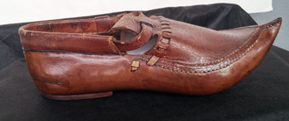
Figure 13 Yemeni (year 1940).13
13Beykoz Shoes Factory Production (Tasev Collection) https://tasevayakkabi.meb.k12.tr/
Shoes/sandal vary in terms of form, materials used in production and techniques applied depending on geographical, social and economic conditions at every stage of human life from birth to death, and constitute an effective language as a means of adornment and status determination as well as the task of protecting the human body.
Sandals have a deeply rooted history and have undergone a geographical, historical and cultural development until today.
Each work bears the traces of the time it belongs to and is an indicator of the level of civilization of the region and period. Shoes of the period are also elements that can be indicative of social and cultural change in terms of the materials, accessories and production techniques used. It is important to develop institutional relations between Universities and Museums, to increase multidisciplinary projects, and to support research by allocating resources to all these studies.
Its contribution to cultural heritage is important with the bridge it creates from the past to the present of this study. The cultural accumulation of sandals and shoes, which has developed and changed in the historical process, is important. By examining this accumulation in terms of materials, design and craftsmanship, it can create a new perspective by opening a space for sustainable design and new material searches.As a conclusion, sandals with its powerful form should be researched on a scientific and artistic basis on national and international platforms.
None.
None.
The author declares that there exists no conflict of interests.

©2025 İmre. This is an open access article distributed under the terms of the, which permits unrestricted use, distribution, and build upon your work non-commercially.